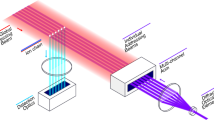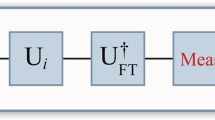Abstract
In many physical systems, when implementing quantum gate operations unavoidable global and relative phases occur as by-products due to the internal structure of the governing Hamiltonian. To correct, additional phase rotation gates are used, which increases the computational overhead. Here, we show how these phase by-products can actually be used to our advantage by using them to implement universal quantum computing between qubits not directly coupled to each other. The gate operations, CNOT, Toffoli, and swap gates, require much less computational overhead than present schemes, and are achieved with fidelity greater than 99%. We then present a linear nearest-neighbor architecture that takes full advantage of the phase by-products, and we show how to implement gates from a universal set efficiently in this layout. In this scheme gate operations are realized by only varying a single control parameter per data qubit, and the ability to tune couplings is not required.
Similar content being viewed by others
Abbreviations
- LNN:
-
Linear nearest neighbor
- CNOT:
-
Controlled-NOT
References
Nielson M.A., Chuang I.L.: Quantum Computation and Quantum Information. Cambridge University Press, Cambridge (2001)
Makhlin Y., Schon G., Shnirman A.: Quantum state engineering with Josephson-junction devices. Rev. Mod. Phys. 73, 357–400 (2001)
Cirac J.J., Zoller P.: A scalable quantum computer with ions in an array of microtraps. Nature 404, 579–581 (2000)
Gershenfeld N.A., Chuang I.L.: Bulk spin resonance quantum computation. Science 275, 350–356 (1997)
Wei L.F., Liu Y., Nori F.: Quantum computation with Josephson qubits using a current-biased information bus. Phys. Rev. B 71, 134506.1–134506.12 (2005)
Gagnebin P.K., Skinner S.R., Behrman E.C., Steck J.E., Zhou Z., Han S.: Quantum gates using a pulsed bias scheme. Phys. Rev. A 72, 042311 (2005)
Majer J.B., Paauw F.G., ter Haar A.C.J., Harmans C.J.P.M., Mooij J.E.: Spectroscopy on two coupled superconducting flux qubits. Phys. Rev. Lett. 94, l090501 (2005)
Kane B.E.: A silicon-based nuclear spin quantum computer. Nat. Lond. 393, 133–136 (1998)
Hollenberg L.C.L., Dzurak A.S., Wellard C., Hamilton A.R., Reilly D.J., Milburn G.J., Clark R.G.: Charge-based quantum computing using single donors in semiconductors. Phys. Rev. B 69, 113301–113304 (2004)
Pachos J.K., Knight P.L.: Quantum computation with a one-dimensional optical lattice. Phys. Rev. Lett. 91, 107902–107905 (2003)
Friesen M., Rugheimer P., Savage D.E., Lagally M.G., van der Weide D.W., Joynt R., Eriksson M.A.: Practical design and simulation of silicon-based quantum-dot qubits. Phys. Rev. B 67, 121301–121304(R) (2003)
Ladd T.D., Goldman J.R., Yamaguchi F., Yamamoto Y.: All-silicon quantum computer. Phys. Rev. Lett. 89, 017901–017904 (2002)
Novais E., Castro Neto A.H.: Nuclear spin qubits in a pseudospin quantum chain. Phys. Rev. A 69, 062312–062317 (2004)
Tian L., Zoller P.: Quantum computing with atomic Josephson-junction arrays. Phys. Rev. A 68, 042321–042330 (2003)
van der Ploeg S.H.W., Izmalkov A., van den Brink A.M., Hübner U., Grajcar M., Il’ichev E., Meyer H.-G., Zagoskin A.M.: Controllable coupling of superconducting flux qubits. Phys. Rev. Lett. 98, 057004–057007 (2007)
Lantz J., Wallquist M., Shumeiko V.S., Wendin G.: Josephson junction qubit network with current-controlled interaction. Phys. Rev. B 70, 140507–140510(R) (2004)
Stock R., James D.F.V.: Scalable, high-speed measurement-based quantum computer using trapped ions. Phys. Rev. Lett. 102, 170501–170504 (2009)
Van Meter R., Ladd T.D., Fowler A.G., Yamamoto Y.: Distributed quantum computation architecture using semiconductor nanophotonics. Int. J. Quantum Inf. 8, 295–323 (2010)
Maslov D.: Linear depth stabilizer and quantum Fourier transformation circuits with no auxiliary qubits in finite neighbor quantum architectures. Phys. Rev. A 76, 052310–052317 (2007)
Shende V.V., Bullock S.S., Markov I.L.: Synthesis of quantum-logic circuits. IEEE Trans. CAD 25(6), 1000–1010 (2006)
Cheung, D., Maslov, D., Severini, S.: Translation techniques between quantum circuit architectures. In: Workshop on Quantum Information Processing (2007, December)
Takahashi Y., Kunihiro N., Ohta K.: The quantum Fourier transform on a linear nearest neighbor architecture. Quantum Inf. Comput. 7, 383–391 (2007)
Kutin, S.A.: Shor’s algorithm on a nearest-neighbor machine. In: Asian Conference on Quantum Information Science (2007)
Choi B.-S., Van Meter R.: On the effect of interaction distance on quantum addition circuits. ACM J. Emerg. Technol. Comput. Syst. 7(3), 11 (2011)
Fowler A.G., Hill C.D., Hollenberg L.C.L.: Quantum error correction on linear nearest neighbor qubit arrays. Phys. Rev. A 69, 042314.1–042314.4 (2004)
Möttönen M., Vartiainen J.J.: Decompositions of General Quantum Gates. Ch. 7 in Trends in Quantum Computing Research. NOVA Publishers, New York (2006)
Chakrabarti A., Sur-Kolay S.: Nearest neighbor based synthesis of quantum Boolean circuits. Eng. Lett. 15, 356–361 (2007)
Khan M.H.A.: Cost reduction in nearest neighbor based synthesis of quantum Boolean circuits. Eng. Lett. 16, 1–5 (2008)
Hirata, Y., Nakanishi, M., Yamashita, S., Nakashima, Y.: An efficient method to convert arbitrary quantum circuits to ones on a linear nearest neighbor architecture. In: International Conference on Quantum, Nano and Micro Technologies, pp. 26–33 (2009)
Fedorov A., Macha P., Feofanov A.K., Harmans C.J.P.M., Mooij J.E.: Tuned transition from quantum to classical for macroscopic quantum states. Phys. Rev. Lett. 106, 170404–170407 (2011)
Zhang J., Whaley K.B.: Generation of quantum logic operations from physical Hamiltonians. Phys. Rev. A 71, 052317–052329 (2005)
Berman G.P., Doolen G.D., Holm G.D., Tsifrinovich V.I.: Quantum computing on a class of one-dimensional Ising systems. Phys. Lett. A 193, 444–450 (1999)
Burkard G., Loss D., DiVincenzo D.P.: Coupled quantum dots as quantum gates. Phys. Rev. B 59, 2070–2078 (1999)
Yamamoto T., Pashkin Y.A., Astafiev O., Nakamura Y., Tsai J.S.: Demonstration of conditional gate operation using superconducting charge qubits. Nature 425, 941–944 (2003)
Lantz, J., Wallquist, M., Shumeiko, V.S., Wendin, G.: Josephson junction qubit network with current-controlled interaction. Phys. Rev. B 70, 140507–140510 (R) (2004)
Kumar, P., Skinner, S.R., Daraeizadeh, S.: Reduced Hamiltonian technique for gate design in strongly coupled quantum systems. In: The 5th International Conference on Quantum Nano and Micro Technologies, Nice, pp. 28–34 (2011)
Kumar P., Skinner S.R.: Universal quantum computing in linear nearest neighbor architectures. Quantum Inf. Comput. 11, 0300–0312 (2011)
Zhou Z., Han S.: A unified approach to realize universal quantum gates in a coupled two-qubit system with fixed always-on couplings. Phys. Rev. B 73, 104521–104524 (2006)
Orlando T.P., Mooij J.E., Tian L., van der Wal C., Levitov L.S., Lloyd S., Mazo J.J.: Superconducting persistent-current qubit. Phys. Rev. B 60, 15398–15413 (1999)
Fowler A.G., Thompson W.F., Yan Z.: Long-range coupling and scalable architecture for superconducting flux qubits. Phys. Rev. B 76, 174507–174513 (2007)
Groszkowski P., Fowler A.G., Motzoi F., Wilhelm F.K.: Tunable coupling between three qubits as a building block for a superconducting quantum computer. Phys. Rev. B 84, 144516–144522 (2011)
Ferber J., Wilhelm M.: Efficient creation of multi-partite entanglement in flux qubits. Nanotechnology 21, 274015 (2010)
Serban I., Solano E., Wilhelm F.K.: Phase-theory for dispersive detectors of superconducting qubits. Phys. Rev. B 76, 104510–104516 (2007)
Author information
Authors and Affiliations
Corresponding author
Additional information
This material is based upon work supported, in part, by the National Science Foundation under Award No. EPS-0903806 and matching support from the State of Kansas through Kansas Technology Enterprise Corporation.
Rights and permissions
About this article
Cite this article
Kumar, P., Skinner, S.R. Using non-ideal gates to implement universal quantum computing between uncoupled qubits. Quantum Inf Process 12, 973–996 (2013). https://doi.org/10.1007/s11128-012-0444-1
Received:
Accepted:
Published:
Issue Date:
DOI: https://doi.org/10.1007/s11128-012-0444-1




